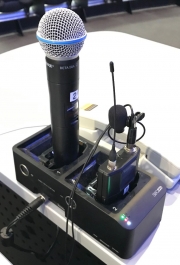Our audiovisual tutorial videos will teach you how to use the equipment in our physical spaces including our AMX touchscreens, document cameras, microphones, monitors and more. You can also read up on our FAQs and get in touch with our AV Technical Support team for further assistance.
Quick Start Guide
AMX Touchscreen in Rooms with One Projector
The AMX touchscreen allows you to control audiovisual equipment in CATS lecture and tutorial rooms. The guide shows you how to use the touchscreen to control the internal PC, document camera and a range of external devices. You’ll also learn how to project information onto the projector in your teaching space.
AMX Touchscreen in Rooms with Two Projectors
The AMX Touchscreen has the capability of controlling two projectors. This guide shows you how to use the touchscreen to control the internal PC, document camera and a range of external devices. You’ll also learn how to project information onto both projectors in your teaching space.
Collaborate Mode
Collaborate mode allows students to share their laptop with the rest of the class. The content on their laptop will display to all other monitors in the room.
Epson Document Camera
The Epson Document Camera allows you to project information onto the projection screen in your teaching space. You can place an object such as a textbook under the camera lens and display the image on the projector screen.
Lumens Document Camera
The Lumens Document Camera allows you to project information onto the projection screen in your teaching space. You can place an object such as a textbook under the camera lens and display the image on the projector screen.
Monitors in Active Learning Spaces
The monitors in active learning spaces allow students to individually work and study. The video tutorial explains how to use the monitors to display content and how to connect your own devices.
Dual Radio Microphones
Key features of the Dual Radio Microphones include:
- physical microphone transmitters, which are located on the lectern in each of the four theatres being trialled (each set consists of one hand-held and one lapel radio mic)
- one extra wireless microphone channel allowing for two-way interaction between students and their teacher, increasing overall student engagement in a lecture class
- clearer audio quality, providing students with a hearing impairment the opportunity for closer collaboration with their peers and teachers, and less hearing fatigue
- option to capture the participants' audio in Lecture Recordings+ and Hybrid Teaching Spaces.
Shure SLX Series Wireless Microphone System
The Shure Microphone System produces high audio quality making verbal presentations audible throughout CATS lecture and tutorial spaces. This system works for both small and large spaces, ensuring your students can hear you from any seat.
